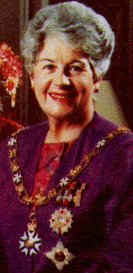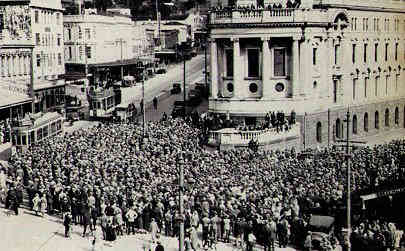![]()
Coasts
Rivers/Lakes
Lowlands/Plains
Geysers/Mud
Glaciers
Mt. Ruapehu
Mt. Cook
White Island
A Maori Legend
![]()
Abbotsford
Aramoana
Ballantynes
Brynderwyns
Cave Creek
Hawkes Bay
H.M.S. Orpheus
Influenza
Mt. Erebus
Mt. Tarawera
Rainbow Warrior
Seacliff Hospital
Tangiwai
Wahine
![]()
Annie Aves
Ata-hoe
Daisy Basham
Jean Batten
Minnie Dean
Mabel Howard
Margaret Mahy
Kath Mansfield
Kate Sheppard
Kiri Te Kanawa
Catherine Tizard
Murray Ball
Charles Goldie
Edmund Hillary
Richard Pearse
Lord Rutherford
Charles Upham
![]()
NZ FAQ--Funny
NZ Links
Credits
"Unless women decide not to have children, they will always be less free and with less energy to pursue their own careers. I don't believe there will ever be a time when the struggle for emancipation will be over. My grandchildren will find different hurdles to overcome from the ones I encountered."--Dame Catherine Tizard. Catherine Anne Tizard became the first woman to be elected Mayor of Auckland in 1983. She followed this up by being appointed Governor General of New Zealand in 1990. Add to this a string of notable awards, including a Dame Commander of the Order of the British Empire, a Dame Grand Cross of the Order of St. Michael and St. George, a New Zealand 1990 Medal, an Honorary Doctorate in Law from Auckland University and a Suffrage Centenary Medal, and Dame Cath has an impressive string of achievements to be proud of. She was born on April 4th, 1931 and grew up in tiny Waharoa, not far from Matamata and attended primary school along with Jack Lasenby who was later to become a successful children's author. As the time to leave school approached Catherine weighed up her options and chose teaching as a career. At that stage options for girls were quite limited. Other than teaching there was hairdressing, nursing, shop work and shorthand typing. Most girls were expected to work for a few short years before settling down and having a family. As Catherine was still too young to attend Teacher's Training college she enrolled at university to study for a Bachelor of Arts degree.
It was at university that Catherine met her future husband, Robert, or 'Bob' Tizard. Within two years of meeting the pair had married and started a family. Anne, Linda, Judith and Nigel were all born within just six years. With husband Bob now fully involved in politics, Catherine was left virtually a solo parent for much of the time as he handled his duties as Labour Member of Parliament for Tamaki. His job took him away to Wellington most weeks on parliamentary business, weekends required attention to his constituency. His only break was on Sundays when a round of golf gave him time-out. In 1961, Catherine returned to university to complete her degree, then in 1962 became a part-time demonstrator in zoology. She followed that up by working as a full-time tutor, at Auckland University, for almost 20-years. Eventually Bob persuaded Cath to put her name forward as a Labour candidate in the Auckland City Council elections. After being elected in 1971 this already busy New Zealander managed to shuffle her life so she could be a hard-working councillor while still holding down her job. During the next few years her confidence in public speaking was increased by appearing on television programmes like "Beauty and the Beast" and her involvement with women's organisation. This once involved chairing a meeting where two and a half thousand delegates were in attendance. In 1980, Catherine decided to stand for the position of Mayor of Auckland City, her marriage to Bob was over and it was time for a new challenge. This was an ambitious idea as Auckland is New Zealand's largest and busiest city. No woman had ever been elected Mayor of a major centre in New Zealand. On her first attempt she failed to gain the position, but tried again in 1983 and was elected. Catherine gave up her job and spent her time chairing meetings, dealing with correspondence, welcoming visitors, opening buildings and attending various events and functions. Despite all the bonuses of her position, chauffer-driven cars, flowers, and priority wherever she went, she still kept her feet firmly on the ground and was often to be found doing the usual hum-drum things like pushing a trolley around the supermarket. December, 1984 was one of the most difficult times of her term as Mayor. It was then that a happy group of people, being entertained by musician Dave Dobbin in Aotea Square, turned nasty. The day had been hot, there was plenty of alcohol being passed around and some of the crowd were looking to stir up trouble. The catalyst for what was to become known as the 'Queen Street Riot' was the sound system breaking down. Police attempted to halt the throwing of bottles and violence which had broken out, but were greatly outnumbered. The trouble escalated when police closed the concert; it spilled out onto Queen Street with over sixty shop windows being broken, bottles thrown and looting. Upon going to see how the Council could assist Cath was shocked to see a man smashing a car with an iron bar. The police were very concerned about her safety, with all the flying bottles and violence, so they persuaded her to leave.
1985 was a happier time with Cath becoming a Dame Commander of the Order of the British Empire. Aotea Centre was a huge issue and that involved Cath in many lawsuits where she represented the Council. Intended as a venue for the performing arts the problems with the building cost millions in legal wrangles, however it was finally completed in 1990. Another big responsibility for Cath was her involvement, as Mayor of Auckland City, in the organising of the Commonwealth Games. These were held in 1990 and were very successful, but before they began Catherine Tizard was offered another first for New Zealand women. She became the first Lady Governor-General of New Zealand and only the third-ever female Governor-General in the world. (The other two were in Belize and Canada). Cath had only just been re-elected for her third term as Mayor of Auckland and had to resign from the position, then move to Government House in Wellington. The job of Governor-General involved many of the same tasks as that of Mayor, though security was considerably higher. She also had to sign laws, appoint judges and committees, open Parliament and bestow royal honours on behalf of the Queen. The Governor-General may also be called upon to dissolve Parliament and call a general election. This very thing had happened back in 1984 when the Prime Minister felt he could no longer command a majority in Parliament. Though the Queen's representative is usually treated with respect Cath was jostled and spat on during the 1995 Waitangi Day celebrations. Despite this treatment Cath was a universally popular Governor-General and made Government House more welcoming for New Zealanders. Dame Catherine Tizard's term as Governor-General ended early in 1996. Daughter Judith entered politics, following her father's footsteps to Parliament.
|



